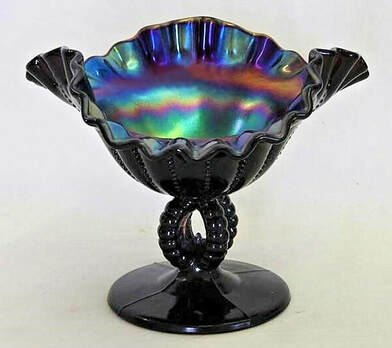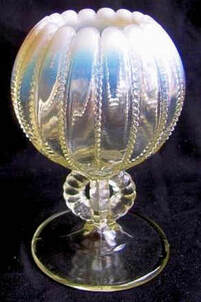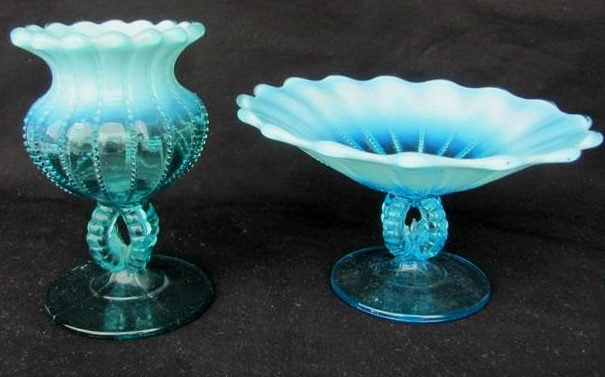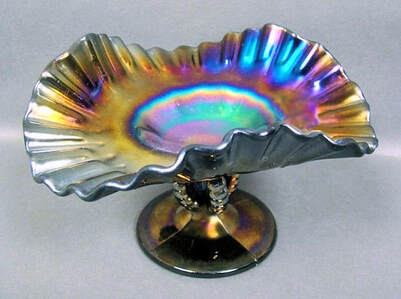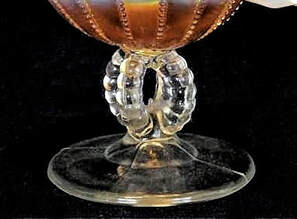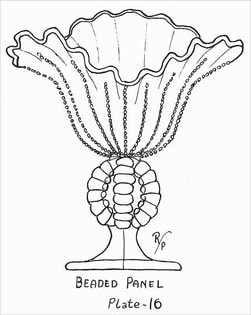Collectors Facts - Beaded Panels, Dugan.
G&S Thistlewood, December 2023.
Classic Carnival Beaded Panel comports in peach opal (left) and purple. Courtesy Seeck Auctions.
Pattern details: probably the most distinctive feature of the Beaded Panels is its amazing stem, made up of four “beaded” columns that are totally separate. There is no glass between them – the space is open. (This changed in later production from c. 1960s, but more about that below). The exterior has rows of tiny beads while the interior is plain and smooth.
Shapes known: stemmed comport. In Carnival Glass, it is known mainly in the tricorner shape (three deep ruffles) usually with a tightly crimped edge. It is also known in Carnival with six ruffles. Other shapes are known in non-iridised glass (see below for more information).
Carnival colours: peach opal, purple, light marigold (sometimes described as clambroth of even smoky), light After Glow pink. Other colours are known in non-iridised glass (see below for more information).
Shapes known: stemmed comport. In Carnival Glass, it is known mainly in the tricorner shape (three deep ruffles) usually with a tightly crimped edge. It is also known in Carnival with six ruffles. Other shapes are known in non-iridised glass (see below for more information).
Carnival colours: peach opal, purple, light marigold (sometimes described as clambroth of even smoky), light After Glow pink. Other colours are known in non-iridised glass (see below for more information).
This is a most interesting piece of glass that has a long and varied back-story. The twists and turns of its ownership are fascinating, reflecting the history of the glassworks where it was first made. Northwood, National Glass, then Dugan and subsequently Diamond Glass all owned the mould when they were in consecutive ownership of the Indiana Glassworks, Pennsylvania. The mould was subsequently owned by the L. G. Wright company from 1939 (glass was made for them by other companies, including Fenton and Westmoreland), and by Fenton itself after Wright closed.
The piece also has many names. Carnival collectors now call it Beaded Panels, which has "morphed" from Beaded Panel (singular), the name originally given to it in Carnival by pioneer/researcher Rose Presznick (Book II, 1st ed.1966). It is also known as Opal Open (and switched around, as Open Opals), Beaded Pearls, Beaded, Beads, and simply Fenton's #2914. That's quite a lot of names for this lovely, little piece of glass.
Its first name – or should we say “number” – however was No. 562.
The very first date we can confirm for this item was in 1899 when it was illustrated in a Pitkin & Brooks catalogue alongside several other items made by The Northwood Company at their Indiana PA glassworks, and it was referenced No. 562. It was included in their catalogue selection described as "Ten and Fifteen Cent Counter Goods" which included other recognisable Northwood items, such as the early style Pump and Trough (which were listed as Nos. 566 and 567).
|
Our pencil style sketch of the No. 562 stemmed rose bowl shape illustrated in the 1899 Pitkin & Brooks catalogue.
|
The No. 562 stemmed rose bowl
shape in flint opal. Courtesy Burns Auctions |
Above: Pitkin & Brooks were, as the signage shows on their wall, “importers and jobbers”. This is their store in Chicago, on the corner of State and Lake Streets, as indicated in the illustration. (Public Domain)
|
Our understanding is that No. 562 was made by Northwood from c. 1899 at the Indiana, Pennsylvania glassworks, in non-iridised opalescent colours - flint opal, blue opal and canary opal. A few years later, after the well-documented changes in ownership of that glass plant from Northwood to The National Glass Company and then subsequently to Thomas Dugan, the No. 562 mould was being used by Dugan at the same location.
Our understanding is that No. 562 was made by Northwood from c. 1899 at the Indiana, Pennsylvania glassworks, in non-iridised opalescent colours - flint opal, blue opal and canary opal. A few years later, after the well-documented changes in ownership of that glass plant from Northwood to The National Glass Company and then subsequently to Thomas Dugan, the No. 562 mould was being used by Dugan at the same location.
|
Dugan’s catalogue c. 1904-1910 - courtesy Steve Jennings. We feature here two images showing the “Grand” Opalescent Novelty Assortment and the “Indian” Opalescent Novelty Assortment that were in this Dugan catalogue. The No. 562 appears in each assortment, but in a different shape (a six-ruffled comport) to that which was shown in the earlier Northwood Pitkin & Brook illustration. The same mould was used, the top section was simply pulled out and ruffled to give a different appearance – this could have been used as a comport or a card receiver. It appears in the "Grand" Assortment, top row 3rd. from the left, and in the "Indian" Assortment, bottom row 2nd from the left. |
Source: Catalog Reprint of Dugan Glass Co. – Jenning’s Design Company.
|
|
Note how Dugan used the No. 562 for this item - the very same number that Northwood had used earlier. Perhaps it was written on the mould that was left at the Indiana works when Northwood left.
The colours made by Dugan were flint opal, blue opal and green opal. Very similar to that which Northwood had previously produced in 1899. |
|
If we now look at Butler Brothers wholesale catalogues, we can also see the No. 562 being offered in 1907 as part of this Dugan selection called a "Big Variety Opalescent Assortment". It is on the far right of the top row, offered again in the same six ruffled shaped comport in blue, green, and flint (clear) opalescent colours. You can also see some of the same Dugan pieces that were in the "Grand" and "Indian" Opalescent Novelty Assortments shown above. These items are all in non-iridescent glass, not Carnival.
Northwood or Dugan? The No. 562 stemmed rose bowl, pinched and flared
and a flattened-out card receiver shape. Both makers produced this item in blue opalescent. Courtesy Burns Auctions. |
Butler Brother’s 1907 ad showing Dugan’s opalescent glass
(not iridised). The No. 562 / Beaded Panel is top right. |
Carnival Production by Dugan
|
Following the opalescent glass production of the No. 562 comport by Dugan, it then had its “day in the sun” in glorious Carnival. In Carnival Glass, it is generally known as “Beaded Panels” and this stemmed comport is found mainly in the tricorner shape (three deep ruffles) usually with a tightly crimped edge. It’s also known with six ruffles. Peach Opal Carnival was the main colour used – that is flint (clear) opalescent glass with a marigold iridescence. Scarce examples of purple and a delicate marigold that may be described as clambroth (or even smoke) are also known. (Cobalt blue is reported but we cannot confirm). |
Despite much searching, we have been unable so far, to find any Dugan ads that showed the No. 562 / Beaded Panels comport in iridised glass.
Despite much searching, we have been unable so far, to find any Dugan ads that showed the No. 562 / Beaded Panels comport in iridised glass.
|
After Glow Production by Diamond
In 1913, a boardroom coup led to the departure of Thomas Dugan (as we first reported in our NetworK ezine #56, January, 2020), and the subsequent name change of the company to Diamond Glassware. Here is Beaded Panels in a 1930 Sommers catalogue in Diamond's After Glow line in pink and green (a "Depression Era" line of pale pink and pale green glass). Examples are known of lightly iridised Beaded Panels in After Glow pink. Although the ad states "Afterglow" as one word, verification back to Diamond's original ad shows it was named "After Glow". A year later, in 1931, a devastating fire would signal the end of the Diamond glass plant at Indiana PA. However, this was not the last sighting of the No. 562 / Beaded Panels comport. A different owner and a name change were on the horizon. Made for L.G. Wright
In 1939, Si Wright acquired some of the Dugan and Diamond moulds that had escaped damage in the 1931 fire. Amongst these was the original No. 562 stemmed comport mould that had been used by Northwood, Dugan and Diamond at the Indiana PA plant. Subsequently Wright also had a larger mould made, and also a new plunger (that created a candle holder interior). The name given to the pattern was simply “Beaded”. Our understanding is that none of these items were made in Carnival. Wright did not make glass, Fenton and Westmoreland probably produced these items for them. |
1930 Sommers catalogue extract.
|
The reproductions made for Wright are easily distinguished from the Northwood and Dugan items as they have a closed-in stem. The Wright catalogue illustration below gives the impression that the stems were open, but in fact in production, there was a film of glass between the four beaded columns that comprise the stem. On the Northwood and Dugan originals, there is no glass between the curving beaded columns in the stem – it is open.
The reproductions made for Wright are easily distinguished from the Northwood and Dugan items as they have a closed-in stem. The Wright catalogue illustration below gives the impression that the stems were open, but in fact in production, there was a film of glass between the four beaded columns that comprise the stem. On the Northwood and Dugan originals, there is no glass between the curving beaded columns in the stem – it is open.
|
Extract from L G Wright’s 1966 catalogue.
Courtesy Glass Paper Fanatics. |
Above: "Beaded " items made for L. G. Wright. In the red item, you can see how the gaps between the parts of the stem are closed and filled with glass. Courtesy Burns Auctions.
Below: a close-up of the "open" stem on the Northwood/Dugan/Diamond originals. |
|
Beaded Panels / No. 562 - The Epilogue?
About 700 or so of the moulds owned by L. G. Wright were auctioned in May 1999. Many (at least 275) of these moulds were bought by Fenton, including - yes you've guessed it! - two of the Beaded Panels moulds, shown below (right) and recorded as "Bead and Panel". Shown below is an extract from Fenton's 2000 general catalogue, and you can see Beaded Panels / No. 562 produced in lightly iridised Willow Green Opalescent Carnival. It was described simply as 2914 G1 Bowl Footed, 6½". The colour was said to be "As fresh as a newly bloomed spring meadow" and that it was based on a Fenton stretch glass colour, Florentine Green" with an opalescent effect. |
"Bead and Panel" moulds - recorded as a 7 inch "goblet" (above) and a 9 inch "comport".
Pictured in the Fenton mould shop. Courtesy of Fenton Art Glass Company and the Fenton Family. The moulds were sold yet again at auction after Fenton closed in July 2011. |
|
What’s in a Name?
This one pattern has a lot of names. As we have seen, it began as No. 562 in 1899, but collectors have given it a variety of names since then. “Opal Open” seems to have been one of the first, and this appears to have been devised by Marion Hartung, illustrated in her 1971 book “Opalescent Pattern Glass”. William Heacock also used the name “Opal Open” around that time. In Hartung’s book, the caption to the drawing states: “The name is derived from the open twisted stem. We have seen this piece in all the usual opalescent colors, plus Peach Carnival”. Although “Opal Open” was the given name, this has also been morphed into “Open Opal” by some collectors and writers. It trips off the tongue more easily! “Beaded Panel” was the name given to the Carnival version of this pattern by Rose Presznick in her Book II, 1st edition, 1966 (the 3rd edition from 1972 is illustrated far right). |
Extract from “Opalescent Pattern Glass” by Marion Hartung. Courtesy Internet Archive digitised books.
|
Extract from “Carnival and Iridescent Glass”
by Rose M. Presznick. |
Presznick reported that it was known in what we call peach opal as well as marigold and amethyst (she also mentioned green, but that was undoubtedly wishful/mistaken thinking). Both Hartung and Presznick stated that they believed the item was made by Fenton. This was, of course, in the days before Dugan was known about and researched.
Generally, the pattern names used by Hartung are the ones that have come into common use by Carnival collectors, so it is interesting that Rose Presznick’s choice of name “Beaded Panel” is the one that has been adopted for this item - although the name has "morphed" into the plural, Beaded Panels. Perhaps the reason for this is that the pattern is not shown in any of Hartung’s ten Carnival Patterns books. She only mentioned it in her “Opalescent Pattern Glass” book. However, in a curious twist in the saga of names, Hartung does name a pattern “Beaded Panels” in her Book 10, but she bestowed the name on a Depression Era powder jar (possibly made by Jeannette Glass).
Finally, we can also add “Beaded Pearls”, “Beaded” and “Beads” to the list of names. Quite a lot of names for this lovely, little piece of glass.
See more Collectors Facts

